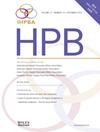The impact of FDG-PET/CT on the diagnostic pathway of surgically treated pancreatic ductal adenocarcinoma: the Surg-Panc-UK study
IF 2.4
3区 医学
Q2 GASTROENTEROLOGY & HEPATOLOGY
引用次数: 0
Abstract
Background
In the UK, NICE recommends FDG-PET/CT (PET/CT) in patients undergoing surgery for pancreatic ductal adenocarcinoma (PDAC) though the impact upon the patient pathway is unclear and was not tested in the PETPANC study.
Methods
National retrospective observational cohort study of consecutive patients undergoing surgery for PDAC. The primary outcome was the difference in diagnostic pathway length with and without a PET/CT. Secondary outcomes determined differences in investigations, resection rates and survival one year after surgery.
Results
Of 830 patients included, 26.5% underwent PET/CT, associated with a significantly longer diagnostic pathway (median 20.5 additional days). PET/CT was associated with more multidisciplinary meetings and investigations, but did not alter resectability rates (90.3% vs 89.1%, PET/CT vs no PET/CT; p = .600), or facilitate operating on patients with more borderline disease (vascular resection 15.1% vs 13.6% PET/CT vs no PET/CT; p = .651). There was no difference in intra-operative unresectability or 12-month survival. There was an increase in MRI use after implementation of the guidelines among patients not undergoing PET/CT, suggesting teams developed different staging strategies.
Conclusion
This national study demonstrates patients undergoing a PET/CT experience a diagnostic pathway that is one third longer, with more investigations, without a difference in resectability rates or survival.
FDG-PET/CT对手术治疗胰腺导管腺癌诊断途径的影响:surgery - panc - uk研究
背景:在英国,NICE推荐在接受胰导管腺癌(PDAC)手术的患者中使用FDG-PET/CT (PET/CT),尽管其对患者通路的影响尚不清楚,也未在PETPANC研究中进行测试。方法:对连续接受PDAC手术的患者进行全国性回顾性观察队列研究。主要结果是有无PET/CT诊断路径长度的差异。次要结局决定了调查、切除率和术后一年生存率的差异。结果:在纳入的830例患者中,26.5%的患者接受了PET/CT检查,诊断途径明显延长(中位数增加20.5天)。PET/CT与更多的多学科会议和调查相关,但没有改变可切除率(90.3% vs 89.1%, PET/CT vs无PET/CT;p = 0.600),或便于对更多边缘性疾病患者进行手术(血管切除术15.1% vs 13.6% PET/CT vs无PET/CT;P = .651)。术中不可切除性和12个月生存率无差异。在未接受PET/CT的患者中,实施指南后MRI的使用有所增加,这表明团队制定了不同的分期策略。结论:这项全国性的研究表明,接受PET/CT检查的患者的诊断途径延长了三分之一,检查次数更多,但在可切除率和生存率方面没有差异。
本文章由计算机程序翻译,如有差异,请以英文原文为准。
求助全文
约1分钟内获得全文
求助全文
来源期刊

Hpb
GASTROENTEROLOGY & HEPATOLOGY-SURGERY
CiteScore
5.60
自引率
3.40%
发文量
244
审稿时长
57 days
期刊介绍:
HPB is an international forum for clinical, scientific and educational communication.
Twelve issues a year bring the reader leading articles, expert reviews, original articles, images, editorials, and reader correspondence encompassing all aspects of benign and malignant hepatobiliary disease and its management. HPB features relevant aspects of clinical and translational research and practice.
Specific areas of interest include HPB diseases encountered globally by clinical practitioners in this specialist field of gastrointestinal surgery. The journal addresses the challenges faced in the management of cancer involving the liver, biliary system and pancreas. While surgical oncology represents a large part of HPB practice, submission of manuscripts relating to liver and pancreas transplantation, the treatment of benign conditions such as acute and chronic pancreatitis, and those relating to hepatobiliary infection and inflammation are also welcomed. There will be a focus on developing a multidisciplinary approach to diagnosis and treatment with endoscopic and laparoscopic approaches, radiological interventions and surgical techniques being strongly represented. HPB welcomes submission of manuscripts in all these areas and in scientific focused research that has clear clinical relevance to HPB surgical practice.
HPB aims to help its readers - surgeons, physicians, radiologists and basic scientists - to develop their knowledge and practice. HPB will be of interest to specialists involved in the management of hepatobiliary and pancreatic disease however will also inform those working in related fields.
Abstracted and Indexed in:
MEDLINE®
EMBASE
PubMed
Science Citation Index Expanded
Academic Search (EBSCO)
HPB is owned by the International Hepato-Pancreato-Biliary Association (IHPBA) and is also the official Journal of the American Hepato-Pancreato-Biliary Association (AHPBA), the Asian-Pacific Hepato Pancreatic Biliary Association (A-PHPBA) and the European-African Hepato-Pancreatic Biliary Association (E-AHPBA).
 求助内容:
求助内容: 应助结果提醒方式:
应助结果提醒方式:


